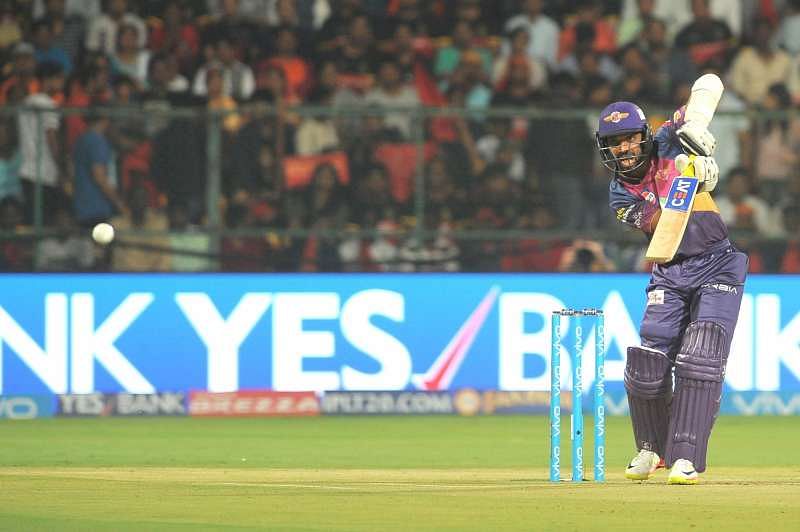
IPL 2017: Dilemma of Ajinkya Rahane's T20 batting

Ajinkya Rahane looked in prime form when he batted against Mumbai Indians on Sunday at the Wankhede stadium. He began with a six over covers in the first over and then drove McClenaghan and Johnson for boundaries courtesy of classical straight drives.
Later he scored fours through cover and midwicket with sublime timing but the shot of the day came against Karn Sharma. On a ball that straightened after pitching and was heading towards off stump, Rahane went on the back foot and punched it wide of mid-on with beautiful yet subtle wrist work.
The Pune opener made his first mistake by trying to cut Sharma on a ball that bounced sharply and in the end offered an easy return catch to the bowler. It was surprising to see such an ugly dismissal but what was even more surprising was Rahane’s stats for the match.
Numbers paint a story of their own
Even after playing such lovely strokes, this right-hand batsman managed to get only 38 runs from 32 balls. His strike rate of 118.75 doesn’t reveal how comfortable he was at the crease. Unfortunately, this incident isn’t an exception but is a reflection of Rahane’s performance in this IPL. Somehow his batting class hasn’t been reflected in numbers.
Rahane, who led the Indian Test team in Virat Kohli’s absence earlier this year has played seven innings so far in this IPL and has managed to score only 159 runs at an average of 22.71. However, the trouble lies with his strike rate which is a mere 127.20. Except for Shikhar Dhawan (118.09, and MS Dhoni (112.17) all other batsmen who have faced more than 100 balls in this season have a better strike rate than Rahane.
This Indian international has faced the issue of strike rate throughout his career. His overall strike rate in IPL is 121.26. In the list top 20 run scorers in IPL, only Jacques Kallis (109.22) and Shikhar Dhawan (120.83) have lesser strike rates than him.
All play and no power?
Another issue with Rahane is his performance in the first six overs. In the powerplay overs only two fielders are outside thirty-yard circle and hence batsmen have more chances of scoring boundaries. Plus the new ball comes to the bat nicely making it easy for the batsmen to play their strokes.
Hence, the onus of scoring boundaries lies on the shoulders of openers and this is where Rahane has hurt Rising Pune Supergiants. He has scored 22 boundaries in 125 balls so far which includes 17 fours and two sixes. He has scored a boundary every 5.68 balls. Among all openers, only Shikhar Dhawan has taken more balls to score a boundary (6.63) in IPL 2017.
Although this boundary scoring percentage is a worry for Rahane, it is not the most crucial reason for his lower strike rate. 2015 was the best year for Rahane in IPL as he scored 540 runs at an astonishing average of 49.09. His strike rate that year was 130.75 which is his highest in a season. However, in the same year, he managed 66 boundaries (53 fours and 13 sixes) from 413 balls which mean he scored a boundary every 6.25 balls. This stat shows that Rahane in the past has scored runs at a better rate even without scoring boundaries frequently.
Also read: After Jadeja, Hardik Pandya and Rohit Sharma, Rahane takes the #BreakTheBeard challenge
The bottom line
Then what is affecting the Rising Pune Supergiant opener from scoring quickly? The answer lies in his dot ball percentage. Out of the 125 deliveries, Rahane has faced, 46 have been dot balls. His dot ball percentage of 27.17 is again one of the highest among all the openers in IPL. He could manage a dot ball percentage of below 40% only thrice in his seven innings so far.
Even in his last match against Mumbai Indians, he faced 15 dot balls in 32 balls which was the reason for his poor stats. This flaw of facing too many dot balls is the reason why even after scoring boundaries frequently; this Indian opener has a strike rate of 127.20.
This former Rajasthan Royals’ opening batsmen has scored 53 singles and four doubles in this year so far. His dot ball percentage (27.17) is higher than his singles percentage (23.58). This factor has not only resulted in increasing the pressure but has also led to his downfall on numerous occasions.
Ajinkya Rahane rose from the ranks banking on his impeccable batting technique and hunger for improvement. His success in varying conditions in the longer format of the game shows his determination and ability to accommodate changes.
T20 cricket has always remained a challenge for him. By playing innovative strokes and scoring boundaries frequently, this right-hand batsman has proved that he can sustain in this format as well. Now, he faces the challenge of mastering this format. And for that, he has to focus on rotating the strike on regular basis and working out a plan that allows him to balance boundaries and singles and doubles effectively.